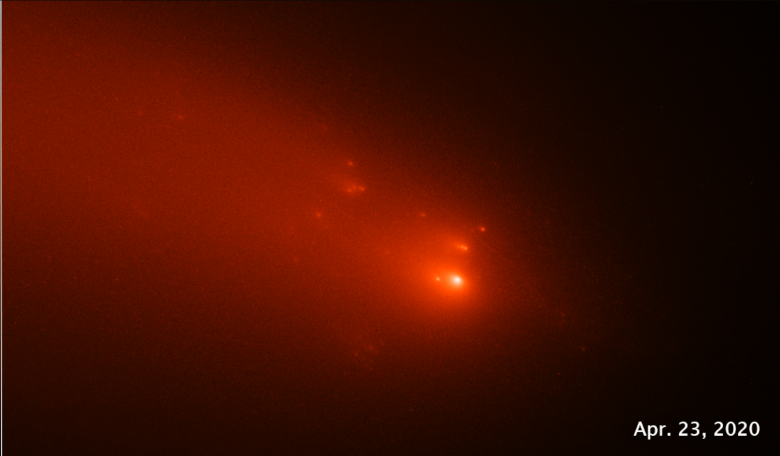“Weird” comet ATLAS, which lit up the sky in 2020 become succumbing to an untimely death later that same year, was a broken off piece from a larger comet that swung by the Sun 5,000 years ago, say scientists studying this unusual icy space visitor.
It is suspected that about 5,000 years ago at around the end of the Stone Age, civilisations across Eurasia and North Africa were treated to a spectacular sight as a large comet swept within 37 million kilometres (23 million miles) of the Sun – an orbit closer than the innermost planet Mercury makes.
But not much is known about this sighting, so how do astronomers know that there was such a space visitor made an appearance all of those years ago? The answer is comet ATLAS (C/2019 Y4).
Discovered by its namesake in December 2019, the Asteroid Terrestrial-impact Last Alert System (ATLAS), a robotic astronomical survey system based in Hawaii, Comet ATLAS was believed to be one of the brightest comets to sweep past Earth in the last two decades.
However, after brightening up the skies for a few months, the object started to go dim and telescopes soon spotted that ATLAS was beginning to disintegrate.
“This is really exciting — both because such events are super cool to watch and because they do not happen very often,” said Quanzhi Ye, the leader of a Hubble observing team watching the breakup last year.
By mid April, it was confirmed that comet ATLAS had fragmented into at least 25 - 30 pieces each roughly the size of a house. But not before German amateur astronomer and comet expert Maik Meyer had noted that its orbit closely resembled that of another long period comet (LPC) known as the Great Comet, or C/1844 Y1.
According to a second-hand report by François Arago in March 1845 in the Comptes rendus de l'Académie des sciences, the Great Comet was first observed in Guyana at dusk on 16 December, 1844, although no information as to the actual discover was mentioned.
It turns out Meyer was right, as after analysing data from the space telescope, Ye, who is based at the University of Maryland, confirms that ATLAS follows the same orbital "railroad track" as C/1844 Y1 and that the two most likely once belonged to a parent comet that broke apart many centuries earlier.
Only two long-period comet (LPC) families have been unambiguously identified: the well-known Kreutz sungrazing comet family which contains over 4,000 known fragments as well as the Liller–Tabur– SWAN group, say Ye and colleagues in their paper published in the Astronomical Journal.
And it's not just that it might be relatively rare that makes comet ATLAS special; it's also because it's "weird," says Ye.
Unlike its ancient hypothesised parent comet, ATLAS disintegrated while it was farther from the Sun than Earth, at a distance of over 161 million kilometres (100 million miles).
This was much farther than the distance where its parent passed the Sun. "This emphasises its strangeness," Ye says.
"If it broke up this far from the Sun, how did it survive the last passage around the Sun 5,000 years ago? This is the big question," Ye adds. "It's very unusual because we wouldn't expect it. This is the first time a long-period comet family member was seen breaking up before passing closer to the Sun."
Clues as to why this might be the case can be gathered from the way it broke up. Comets are traditionally viewed as fragile agglomerations of dust and ice, but one fragment of ATLAS disintegrated in a matter of days, while another piece lasted for weeks. "This tells us that part of the nucleus was stronger than the other part," Ye says.
The cause of the initial fragmentation is still undetermined says Ye, but it might have been caused by streamers of ejected material that spun up the comet so fast centrifugal forces tore it apart. Alternatively, gases from so-called super-volatile ices just blew the piece apart like an exploding aerial firework. "Comet ATLAS's behavior is interesting but hard to explain." Ye concludes.
Astronomers will have a long wait to test out any further theories on the family connection between Comet ATLAS and its surviving sibling, as C/1844 Y1 won't return to our patch of the skies until the 50th century.











